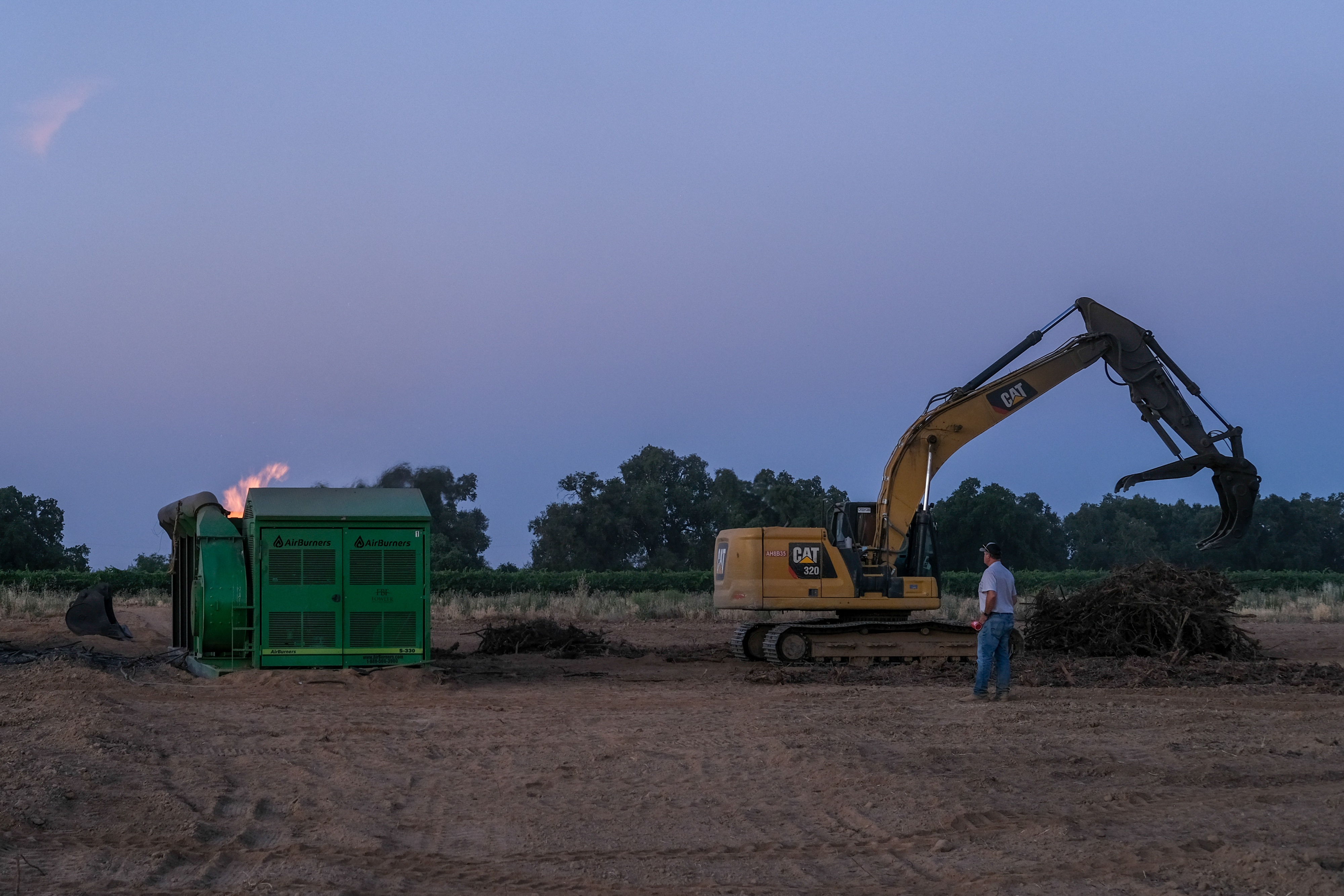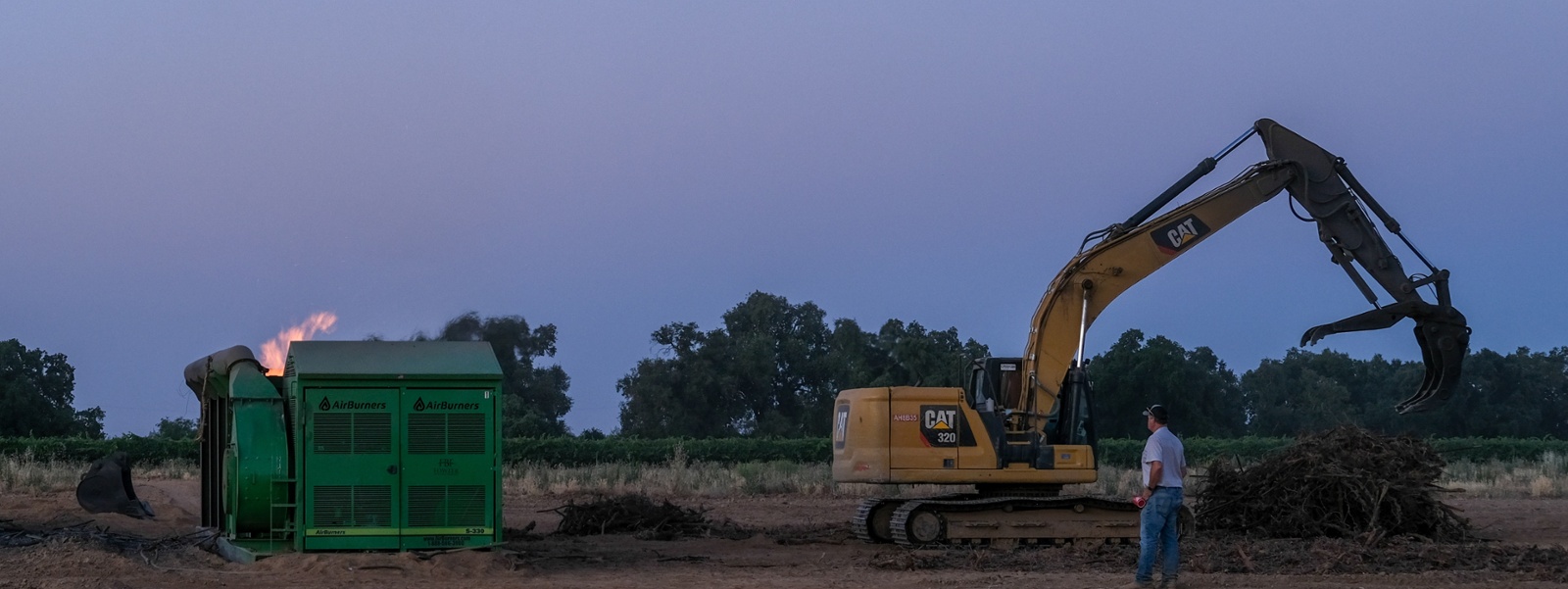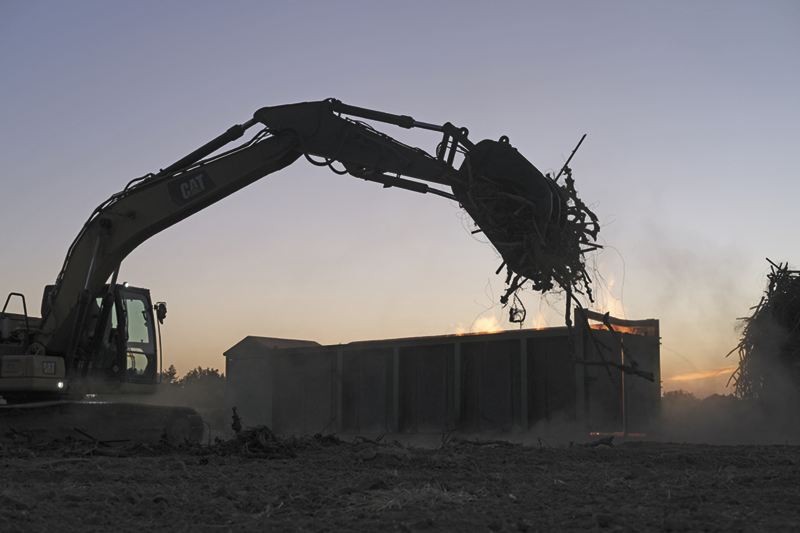Farmers weigh options as burn ban nears

Randy Baranek, project manager for the agricultural service provider Fowler Brothers, looks on as foreman Alex Noriega uses an excavator to place discarded grapevines into an air curtain burner last month in Lodi. The device has gained traction on farms as a ban on open agricultural burning nears.
Photo/Caleb Hampton


Photo/Caleb Hampton
By Caleb Hampton
At 4 a.m. in Lodi, Alex Noriega, foreman for the agricultural service provider Fowler Brothers, climbed onto an excavator to rip apart discarded grapevines and drop them into a cement-lined steel box called an air curtain burner for smokeless burning.
The disposal method is one of a few options San Joaquin Valley farmers have turned to as the region phases out open agricultural burning. On Jan. 1, farmers in the eight counties in the San Joaquin Valley Air Pollution Control District will be prohibited from nearly all open burning under a state law adopted in 2003.
The law aimed to address the health impacts of poor air quality on largely Latino farm towns in the San Joaquin Valley, where the air quality is among the worst in the nation.
Agricultural burning, which accounts for about 4% of the region’s fine particulate pollution, has long been the least expensive and easiest way to dispose of orchard and vineyard removals. Eliminating it poses challenges.
“It’s real difficult when you can’t burn,” said Michael Naito, who grows winegrapes, table grapes, almonds and pistachios in Fresno and Madera counties.
Burning materials from crops such as wheat, rice and some fruit trees was already banned. But a lack of affordable alternatives for disposing of vines and most tree crops postponed a total ban until the California Air Resources Board in 2021 directed the valley air district to end all agricultural burning by 2025.
Since then, the district has imposed restrictions to phase out the practice. Grant programs to fund alternative methods, coupled with the phaseout, caused the amount of agricultural material burned in the valley to fall by more than 80% from 2019 to 2023, according to air district data.
“We’re seeing similar trends so far this year, too,” said Robert Gilles, program manager for the district.
The largest growers were the first to have burning restricted. This year, growers with more than 100 to 250 acres, depending on specific farming practices, are prohibited from burning. Next year, open burning will be prohibited even for small growers. Farms of any size will still be able to seek permits to burn attrition piles and diseased trees and vines.
As more farmers come under the ban, they are searching for alternatives to burning and raising questions about the viability of adopting new methods.
The primary alternative is to grind trees or vines into mulch using a woodchipper. But doing that requires heavy equipment, depends on the availability of agricultural service providers and costs much more than burning. “It’s not cheap,” Naito said.
Adding to the challenge is increased demand to clear removals from farmland. The timing of the burn ban has coincided with limitations on groundwater pumping in the San Joaquin Valley and poor commodity prices that have driven farmers to tear out more nut trees. Meanwhile, a historic downturn in the wine market has prompted winegrape growers to remove some 30,000 acres of vineyards this year, about 5% of the state’s bearing acreage.
Vineyard disposal, which accounts for most of the agricultural burning in the valley, is especially difficult because of metal stakes and wires embedded in grapevines.
“It’s just a lot more hand labor,” Naito said.
This year, he removed 70 acres of zinfandel and Thompson Seedless grapevines. “We rolled up the drip hose, cut the wire and took out all the stakes and wires and trellises,” Naito said. “Then they came in and stacked it and shredded it all up.”
Air curtain burners, commonly used by government agencies to reduce wildfire fuels and clean up debris after natural disasters, have emerged as another tool for vineyard disposal. The shipping container-size burn boxes have fans that force smoke particles downward, where they burn again and the particles break up. According to government agencies, the method reduces harmful emissions by 80% to 90%.
“This is how everything is going to need to be burned in the San Joaquin Valley starting Jan. 1,” said Randy Baranek, project manager for Fowler Brothers, one of few agricultural service providers that has purchased an air curtain burner.
The burn box costs $300,000, weighs 60,000 pounds and requires a crane and a flatbed truck to transport. During the past several months, Baranek has supervised vineyard disposals from Lodi to Bakersfield. “These burners have been working five to six days a week consistently all year,” he said.
The company recently acquired a third air curtain burner to keep up with demand. But the expense of the equipment and its transport can make it cost-prohibitive for operators to serve farmers with small land parcels.
“I have a set cost to move this thing in, whether it’s a 100-acre field or a 10-acre field,” Baranek said. That base cost is about $3,000. “For a 10-acre grower, that’s $300 an acre. For a 100-acre grower, that’s $30 an acre. So, what do you do?”
In 2018, the air district launched a funding initiative called the Alternative to Open Ag Burning Incentive Program, offering farmers grants of $300 to $1,300 per acre, depending on the type of farming and the removal method, to offset removal costs. Farms smaller than 100 acres receive an additional $400 per acre.
Jeff Bitter, who grows winegrapes in Fresno County and is president of Allied Grape Growers, called the program a “lifesaver.” But future funding is uncertain. An initial $178 million provided by the state budget in 2021 has been exhausted, air district officials said.
The air district’s governing board recently approved $43 million to keep the program afloat for the fiscal year that began July 1, using funds from the district’s operating budget. Aaron Tarango, grant program manager for the district, said it is “doing what it can” to continue the grant program. But he said the district “can’t guarantee money” past June 2025 without board approval.
Earlier this year, the program reduced the maximum acreage for which a grower can get grants—from 500 to 250 per year.
Farmers may also apply for grants from the U.S. Department of Agriculture Natural Resources Conservation Service to grind their trees or vines into mulch. That initiative offers similar rates per acre but is overall a smaller pool of funds than the air district incentive program, and it is limited to mulching methods.
With no guarantee of long-term funding, there is a risk, growers said, that farmers with out-of-favor crops such as winegrapes or walnuts will be able to afford neither the cost of farming nor the cost of removals.
“I would predict that if the funding isn’t there that there would be more vineyards and orchards that people will just walk away from and leave them abandoned,” Naito said. “It’s just a breeding ground for different pests to overwinter. That becomes a big problem.”
Bitter has already begun seeing abandoned vineyards. He said, “I think we’re going to see more.”
(Caleb Hampton is an assistant editor of Ag Alert. He may be contacted at champton@cfbf.com.)




